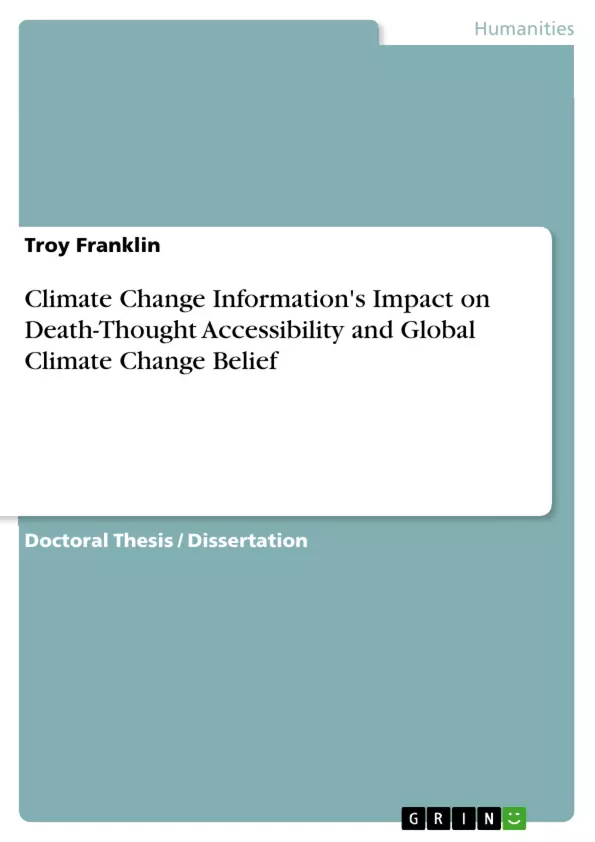Global climate change is perhaps the greatest current existential threat to life on this planet. Despite the overwhelming scientific consensus for the existence of human-made global climate change, climate change skepticism continues to be a significant obstacle. The purpose of this experimental online study was to address research questions concerning the effect of climate change information on death-thought accessibility (DTA) and belief in global climate change and to investigate whether a relationship exists between DTA and belief certainty in global climate change. Terror management theory was the theoretical foundation for the study. The study sample consisted of 104 participants randomly assigned to two experimental groups and a control group. Group 1 read an essay about the environmental effects of climate change, Group 2 read an essay on the human causes of climate change, and Group 3 (control) read information about rainy weather. A 25-item word completion task was used to measure DTA and a 17-item Likert scale (Whitmarsh Skepticism Scale) measured belief certainty in global climate change. An ANOVA with planned contrasts and an ANCOVA were performed with nonsignificant results, indicating that climate change information alone does not necessarily increase DTA or belief certainty in global climate change, nor does it indicate a relationship between the 2 variables. The findings indicate that more than educational information on climate change may be needed to effect positive social change regarding the issue of global climate change.
Inhaltsverzeichnis (Table of Contents)
- Chapter 1: Introduction
- Introduction and Background
- Problem Statement and Purpose
- Research Questions and Hypotheses
- Theoretical Foundation
- Nature of the Study
- Definition of Terms
- Scope and Delimitations
- Assumptions and Limitations
- Significance of the Study
- Summary
- Chapter 2: Literature Review
- Introduction
- Literature Search Strategy
- Terror Management Theory
- Death-Thought Accessibility
- Global Climate Change: Belief and Information
- Summary
- Chapter 3: Research Method
Zielsetzung und Themenschwerpunkte (Objectives and Key Themes)
This dissertation examines the influence of climate change information on death-thought accessibility (DTA) and global climate change belief. The study investigates whether a relationship exists between DTA and belief certainty in global climate change, drawing upon Terror Management Theory as its theoretical foundation. The research aims to contribute to understanding the psychological factors affecting climate change skepticism.
- The impact of climate change information on DTA.
- The relationship between DTA and belief certainty in global climate change.
- The role of Terror Management Theory in explaining climate change attitudes.
- The potential for educational interventions to address climate change skepticism.
- The broader implications of climate change belief for environmental action.
Zusammenfassung der Kapitel (Chapter Summaries)
Chapter 1 provides an introduction to the study, outlining the research problem, purpose, and hypotheses. It also explores the theoretical foundation, nature of the study, and its significance. Chapter 2 presents a comprehensive literature review, examining relevant theories and research on Terror Management Theory, death-thought accessibility, and global climate change belief. Chapter 3 details the research method used in the study, including the research design, methodology, and procedures.
Schlüsselwörter (Keywords)
The dissertation focuses on key topics such as climate change, death-thought accessibility, belief certainty, Terror Management Theory, and the psychological factors influencing climate change skepticism. The research utilizes an experimental design to investigate the impact of climate change information on individuals' beliefs and attitudes towards the issue.
- Arbeit zitieren
- Troy Franklin (Autor:in), 2020, Climate Change Information's Impact on Death-Thought Accessibility and Global Climate Change Belief, München, GRIN Verlag, https://www.grin.com/document/1365291



